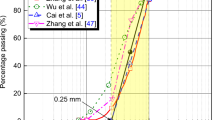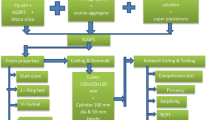Abstract
Most natural sandy deposits contain low amounts of fine content (< 10%), which is usually anisotropic and characterized by complex microstructures. The present study investigates the influence of low silt content on the anisotropic behaviour of sand. For this purpose, 30 undrained tests were performed using a hollow cylindrical apparatus with constant α° and b values on Firoozkuh sand. The specimens had silt contents of 0, 3, 5, 7 and 10%, and the inclination angle (α°) was varied from 15° to 60°. The specimens were prepared with the dry deposition method and subjected to confining pressures of 100 and 200 kPa. The equivalent intergranular relative density parameter was then introduced in order to create a comparative basis for the specimens. The experimental results show that increasing α leads to more contractive behaviour in the pure sand. By adding silt particles to the host sand up to 5%, the peak strength of the specimen is increased (18.5%, 12% and 7.7% for α = 15°, 30° and 60°, respectively), and the strength of the specimen is decreased. It should be noted that with a silt content of 10%, the strength of the specimen was lower than that of the host sand (about 12%). On the other hand, it can be seen that with the increase of α, the influence of fine grains as an important parameter in sand-fine mixtures is decreased.
















Similar content being viewed by others
Data availability statement
Data generated or analyzed during this study are provided in full within the published article.
References
Ishihara K, Towhata I (1983) Sand response to cyclic rotation of principal stress directions as induced by wave loads. Soils Found 23(4):11–26. https://doi.org/10.3208/sandf1972.23.4_11
Guo PJ, Stolle DF (2005) On the failure of granular materials with fabric effects. Soils Found 45(4):1–12. https://doi.org/10.3208/sandf.45.4_1
Radjai F, Azéma E (2009) Shear strength of granular materials. Eur J Environ Civil Eng 13(2):203–218. https://doi.org/10.1080/19648189.2009.9693100
Wrzesinski G, Lechowicz Z (2013) Influence of the rotation of principal stress directions on undrained shear strength. Annals of Warsaw University of life sciences-SGGW. Land Reclam. 45(2):183
Shogaki T, Kumagai N (2008) A slope stability analysis considering undrained strength anisotropy of natural clay deposits. Soils Found 48(6):805–819. https://doi.org/10.3208/sandf.48.805
Wrzesiński G (2021) Anisotropy of soil shear strength parameters caused by the principal stress rotation. Arch Civ Eng 67:163–187. https://doi.org/10.24425/ace.2021.136467
Pradel D, Ishihara K, Gutierrez M (1990) Yielding and flow of sand under principal stress axes rotation. Soils Found 30(1):87–99. https://doi.org/10.3208/sandf1972.30.87
Gutierrez M, Ishihara K, Towhata I (1991) Flow theory for sand during rotation of principal stress direction. Soils Found 31(4):121–132. https://doi.org/10.3208/sandf1972.31.4_121
Sivathayalan S, Vaid Y (2002) Influence of generalized initial state and principal stress rotation on the undrained response of sands. Can Geotech J 39(1):63–76. https://doi.org/10.1139/t01-078
Lade PV, Nam J, Hong WP (2008) Shear banding and cross-anisotropic behavior observed in laboratory sand tests with stress rotation. Can Geotech J 45(1):74–84. https://doi.org/10.1139/T07-078
Rodriguez NM, Lade PV (2013) Effects of principal stress directions and mean normal stress on failure criterion for cross-anisotropic sand. J Eng Mech 139(11):1592–1601. https://doi.org/10.1061/(ASCE)EM.1943-7889.0000595
Farshbaf Aghajani H, Salehzadeh H (2015) Anisotropic behavior of the Bushehr carbonate sand in the Persian Gulf. Arab J Geosci 8:8197–8217. https://doi.org/10.1007/s12517-014-1758
Yang L-T et al (2016) A laboratory study of anisotropic geomaterials incorporating recent micromechanical understanding. Acta Geotech 11:1111–1129. https://doi.org/10.1007/s11440-015-0423-7
Ghadr S, Bahadori H, Assadi-Langroudi A (2019) Anisotropy in sand–fibre composites and undrained stress–strain implications. Int J Geosynth Ground Eng 5:1–13. https://doi.org/10.1007/s40891-019-0174-x
Al-Rkaby AH, Nikraz H, Chegenizadeh A (2017) Stress and deformation characteristics of nonwoven geotextile reinforced sand under different directions of principal stress. Int J Geosynth Ground Eng 3:1–11. https://doi.org/10.1007/s40891-017-0111-9
Yoshimine M, Ishihara K, Vargas W (1998) Effects of principal stress direction and intermediate principal stress on undrained shear behavior of sand. Soils Found 38(3):179–188. https://doi.org/10.3208/sandf.38.3_179
Uthayakumar M, Vaid Y (1998) Static liquefaction of sands under multiaxial loading. Can Geotech J 35(2):273–283. https://doi.org/10.1139/t98-007
Bahadori H, Ghalandarzadeh A, Towhata I (2008) Effect of non plastic silt on the anisotropic behavior of sand. Soils Found 48(4):531–545. https://doi.org/10.3208/sandf.48.531
Kumruzzaman M, Yin J-H (2010) Influences of principal stress direction and intermediate principal stress on the stress–strain–strength behaviour of completely decomposed granite. Can Geotech J 47(2):164–179. https://doi.org/10.1139/T09-079
Cai Y et al (2013) Noncoaxial behavior of sand under various stress paths. J Geotech Geoenviron Eng 139(8):1381–1395. https://doi.org/10.1061/(ASCE)GT.1943-5606.0000854
Wrzesiński G, Lechowicz Z (2015) Testing of undrained shear strength in a hollow cylinder apparatus. Stud Geotechn Mech 37(2):69–73. https://doi.org/10.1515/sgem-2015-0023
Xiong H et al (2016) Experimental study of drained anisotropy of granular soils involving rotation of principal stress direction. Eur J Environ Civil Eng 20(4):431–454. https://doi.org/10.1080/19648189.2015.1039662
Salgado R, Bandini P, Karim A (2000) Shear strength and stiffness of silty sand. J Geotech Geoenviron Eng 126(5):451–462. https://doi.org/10.1061/(ASCE)1090-0241(2000)126:5(451)
Missoum H et al (2013) Laboratory investigation into the effects of silty fines on liquefaction susceptibility of Chlef (Algeria) sandy soils. Geotech Geol Eng 31:279–296. https://doi.org/10.1007/s10706-012-9590-6
Peng D et al (2018) Distribution and failure modes of the landslides in Heitai terrace. Chin Eng Geol 236:97–110. https://doi.org/10.1016/j.enggeo.2017.09.016
Krim A et al (2019) Experimental study on the liquefaction resistance of sand–clay mixtures: effect of clay content and grading characteristics. Mar Georesour Geotechnol 37(2):129–141. https://doi.org/10.1080/1064119X.2017.1407974
Guo C, Cui Y (2020) Pore structure characteristics of debris flow source material in the Wenchuan earthquake area. Eng Geol 267:105499. https://doi.org/10.1016/j.enggeo.2020.105499
Yamamuro JA, Lade PV (1998) Steady-state concepts and static liquefaction of silty sands. J Geotech Geoenviron Eng 124(9):868–877. https://doi.org/10.1061/(ASCE)1090-0241(1998)124:9(868)
Chang CS, Yin Z-Y (2011) Micromechanical modeling for behavior of silty sand with influence of fine content. Int J Solids Struct 48(19):2655–2667. https://doi.org/10.1016/j.ijsolstr.2011.05.014
Yin Z-Y, Zhao J, Hicher P-Y (2014) A micromechanics-based model for sand-silt mixtures. Int J Solids Struct 51(6):1350–1363. https://doi.org/10.1016/j.ijsolstr.2013.12.027
Jradi L et al (2022) Influence of low fines content on the liquefaction resistance of sands. Eur J Environ Civil Eng 26(12):6012–6031. https://doi.org/10.1080/19648189.2021.1927195
Yamamuro JA, Covert KM (2001) Monotonic and cyclic liquefaction of very loose sands with high silt content. J Geotech Geoenviron Eng 127(4):314–324. https://doi.org/10.1061/(ASCE)1090-0241(2001)127:4(314)
Zlatovic S, Ishihara K (1997) Normalized behavior of very loose non-plastic soils: effects of fabric. Soils Found 37(4):47–56. https://doi.org/10.3208/sandf.37.4_47
Lade PV, Yamamuro JA (1997) Effects of nonplastic fines on static liquefaction of sands. Can Geotech J 34(6):918–928. https://doi.org/10.1139/t97-052
Stamatopoulos CA (2010) An experimental study of the liquefaction strength of silty sands in terms of the state parameter. Soil Dyn Earthq Eng 30(8):662–678. https://doi.org/10.1016/j.soildyn.2010.02.008
Amini F, Qi G (2000) Liquefaction testing of stratified silty sands. J Geotech Geoenviron Eng 126(3):208–217. https://doi.org/10.1061/(ASCE)1090-0241(2000)126:3(208)
Khayat N, Ghalandarzadeh A, Jafari MK (2014) Grain shape effect on the anisotropic behaviour of silt–sand mixtures. Geotech. Eng. J 167(3):281–296. https://doi.org/10.1680/geng.11.00093
Polito CP, Martin JR (2003) A reconciliation of the effects of non-plastic fines on the liquefaction resistance of sands reported in the literature. Earthq Spectra 19(3):635–651. https://doi.org/10.1193/1.1597878
Huang Y-T et al (2004) A laboratory study on the undrained strength of a silty sand from Central Western Taiwan. Soil Dyn Earthq Eng 24(9–10):733–743. https://doi.org/10.1016/j.soildyn.2004.06.013
Dash H, Sitharam T (2011) Undrained monotonic response of sand–silt mixtures: effect of nonplastic fines. J Geomech Geoeng Int J 6(1):47–58. https://doi.org/10.1080/17486021003706796
ASTM, ASTM. D4253 (2006) Standard test methods for maximum index density and unit weight of soils using a vibratory table. ASTM International, West Conshohocken
ASTM, ASTM. D4253 (2006) Standard test methods for minimum index density and unit weight of soils and calculation ofrelative density. ASTM International, West Conshohocken
Thevanayagam S, Mohan S (2000) Intergranular state variables and stress–strain behaviour of silty sands. Géotechnique 50(1):1–23. https://doi.org/10.1680/geot.2000.50.1.1
Thevanayagam S et al (2002) Undrained fragility of clean sands, silty sands, and sandy silts. J Geotech Geoenviron Eng 128(10):849–859. https://doi.org/10.1061/(ASCE)1090-0241(2002)128:10(849)
Yang S, Sandven R, Grande L (2006) Instability of sand–silt mixtures. Soil Dyn Earthq Eng 26(2–4):183–190. https://doi.org/10.1016/j.soildyn.2004.11.027
Papadopoulou A, Tika T (2008) The effect of fines on critical state and liquefaction resistance characteristics of non-plastic silty sands. Soils Found 48(5):713–725. https://doi.org/10.3208/sandf.48.713
Belkhatir M et al (2010) Influence of inter-granular void ratio on monotonic and cyclic undrained shear response of sandy soils. C R Mecanique 338(5):290–303. https://doi.org/10.1016/j.crme.2010.04.002
Maleki M et al (2011) Effect of physical parameters on static undrained resistance of sandy soil with low silt content. Soil Dyn Earthq Eng 31(10):1324–1331. https://doi.org/10.1016/j.soildyn.2011.05.003
Cabalar A, Hasan R (2013) Compressional behaviour of various size/shape sand–clay mixtures with different pore fluids. Eng Geol 164:36–49. https://doi.org/10.1016/j.enggeo.2013.06.011
Deng Y et al (2017) Sand fraction effect on hydro-mechanical behavior of sand-clay mixture. Appl Clay Sci 135:355–361. https://doi.org/10.1016/j.clay.2016.10.017
Rahman MM, Lo S, Gnanendran C (2008) On equivalent granular void ratio and steady state behaviour of loose sand with fines. Can Geotech J 45(10):1439–1456. https://doi.org/10.1139/T08-064
Thevanayagam S, Martin G (2002) Liquefaction in silty soils-screening and remediation issues. Soil Dyn Earthq Eng 22(9–12):1035–1042. https://doi.org/10.1016/S0267-7261(02)00128-8
Yang J, Wei L, Dai B (2015) State variables for silty sands: global void ratio or skeleton void ratio? Soils Found 55(1):99–111. https://doi.org/10.1016/j.sandf.2014.12.008
Ni Q et al (2004) Contribution of fines to the compressive strength of mixed soils. Géotechnique 54(9):561–569. https://doi.org/10.1680/geot.2004.54.9.561
Rees, S.D. (2010) Effects of fines on the undrained behaviour of Christchurch sandy soils. PhD thesis, University of Canterbury, Christchurch, New Zealand
Mohammadi A, Qadimi A (2015) A simple critical state approach to predicting the cyclic and monotonic response of sands with different fines contents using the equivalent intergranular void ratio. Acta Geotech 10:587–606. https://doi.org/10.1007/s11440-014-0318-z
Miura S, Toki S (1982) A sample preparation method and its effect on static and cyclic deformation-strength properties of sand. Soils Found 22(1):61–77. https://doi.org/10.3208/sandf1972.22.61
ASTM, ASTM D4767-11 (2020) Standard test method for consolidated undrained triaxial compression test for cohesive soils. ASTM International, West Conshohocken
Yang J, Savidis S, Roemer M (2004) Evaluating liquefaction strength of partially saturated sand. J Geotech Geoenviron Eng 130(9):975–979. https://doi.org/10.1061/(ASCE)1090-0241(2004)130:9(975)
Bouferra R, Benseddiq N, Shahrour I (2007) Saturation and preloading effects on the cyclic behavior of sand. Int J Geomech 7(5):396–401. https://doi.org/10.1061/(ASCE)1532-3641(2007)7:5(396)
Li X, Yu H-S (2009) Influence of loading direction on the behavior of anisotropic granular materials. Int J Eng Sci 47(11–12):1284–1296. https://doi.org/10.1016/j.ijengsci.2009.03.001
Murthy T et al (2007) Undrained monotonic response of clean and silty sands. Géotechnique 57(3):273–288. https://doi.org/10.1680/geot.2007.57.3.273
Bishop AW (1971) Shear strength parameters for undisturbed and remolded soil specimens. Roscoe Memorial Symp. Cambridge University, Cambridge, pp 3–58
Sadrekarimi A (2016) Static liquefaction analysis considering principal stress directions and anisotropy. Geotech Geol Eng 34:1135–1154. https://doi.org/10.1007/s10706-016-0033-7
Keramatikerman M et al (2018) Effect of flyash on liquefaction behaviour of sand-bentonite mixture. Soils Found 58(5):1288–1296. https://doi.org/10.1016/j.sandf.2018.07.004
Zarei C, Soltani-Jigheh H, Badv K (2019) Effect of inherent anisotropy on the behavior of fine-grained cohesive soils. Int J Civ Eng 17:687–697. https://doi.org/10.1007/s40999-018-0292-1
Funding
No funding was received for conducting this study.
Author information
Authors and Affiliations
Contributions
All authors contributed to the study conception and design.
Corresponding author
Ethics declarations
Conflict of interest
The authors have no relevant financial or non-financial interests to disclose.
Rights and permissions
Springer Nature or its licensor (e.g. a society or other partner) holds exclusive rights to this article under a publishing agreement with the author(s) or other rightsholder(s); author self-archiving of the accepted manuscript version of this article is solely governed by the terms of such publishing agreement and applicable law.
About this article
Cite this article
Mohammadi, V., Bahadori, H. Influence of Low Silt Content on the Anisotropic Behaviour of Sand. Int J Civ Eng (2024). https://doi.org/10.1007/s40999-024-00964-3
Received:
Revised:
Accepted:
Published:
DOI: https://doi.org/10.1007/s40999-024-00964-3




